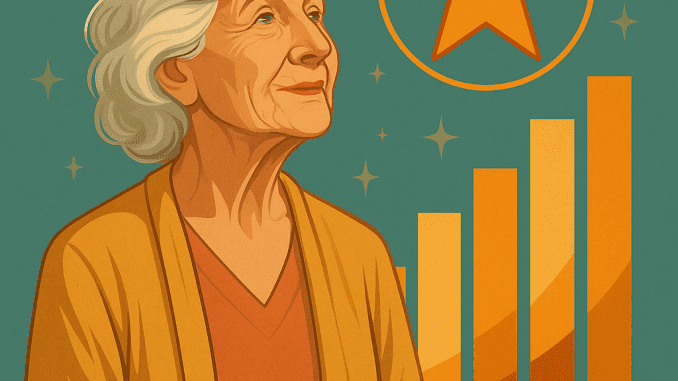
In 2025, the ultimate flex isn’t a Birkin bag or a Bugatti-it’s a biological age younger than your driver’s license. Welcome to the celebrity longevity era, where A-listers like Bryan Johnson, Kim Kardashian, and Halle Berry are pouring millions into biohacking, epigenetic testing, and cutting-edge health tech to outlive-and outshine-their peers. This shift isn’t just about vanity; it’s a cultural revolution redefining what it means to be a celebrity.
From cold plunges to $50,000 gene therapies, stars are turning longevity into the ultimate status symbol. Let’s dive into how the celebrity longevity era is reshaping fame, wealth, and our obsession with aging.
The Rise of the Celebrity Longevity Era
The celebrity longevity era marks a seismic shift in how stars showcase their wealth and influence. Gone are the days of flaunting sports cars or private jets. Today, celebrities are investing in:
- Biological age tests (like Kim Kardashian’s TruDiagnostic reveal on The Kardashians finale)
- Epigenetic therapies (Bryan Johnson’s $2M/year Blueprint protocol)
- Wellness startups (Halle Berry’s menopause-focused Respin Health)
- Biohacking gadgets (Chris Hemsworth’s Centr app)
As Delphine Le Grand noted on LinkedIn, this trend blends science, culture, and capitalism-with celebrities acting as both influencers and investors. The result? A $1.3 trillion longevity market projected to grow 8% annually, fueled by star power and Silicon Valley’s obsession with “defying death.”
Case Study 1: Bryan Johnson and the Blueprint Protocol
Bryan Johnson, a 46-year-old tech entrepreneur, has become the poster child of the celebrity longevity era. His Blueprint regimen includes:
- 78 daily supplements (including a $49 “Longevity Mix” drink)
- Strict vegan diet (70+ lbs of veggies monthly)
- AI-driven health monitoring (tracking 200+ biomarkers)
Johnson’s extreme routine-costing $2M annually-has slashed his biological age to that of a 36-year-old. His Netflix documentary Don’t Die and viral social media posts have turned him into a controversial but influential figure, proving that longevity is now a lifestyle brand.
Case Study 2: The Kardashians and Biological Age Testing
In July 2024, the Kardashians showcased their TruDiagnostic biological age results on Hulu, revealing how their lifestyles impact aging. Kim, 43, boasted a biological age of 38, while Scott Disick’s came in at 52-a 9-year gap from his chronological age. This episode spiked TruDiagnostic’s sales by 300%, illustrating how the celebrity longevity era drives mainstream adoption.
How Celebrities Are Winning the Longevity Game
1. Investing in Biotech Startups
Stars aren’t just endorsing products-they’re funding them:
- Halle Berry: Co-founded Respin Health, focusing on menopause and aging.
- Andrew Huberman: Scientific advisor to AG1 (despite Reddit backlash over its lead content).
- Gwyneth Paltrow: Pushes $150 peptide serums via Goop, claiming to “reverse” aging.
2. Mainstreaming Biohacking
Cold plunges, NAD IV drips, and epigenetic tests are now red-carpet staples:
- Tony Robbins and Hugh Jackman swear by morning ice baths for energy.
- Kevin Love credits NAD IV therapy for his NBA comeback at 36.
- Bryan Johnson hosts $179 “Don’t Die” summits, blending science with celebrity spectacle.
3. Leveraging Social Media
Platforms like TikTok and Instagram are flooded with:
- **#LongevityJourneyosts (7.2M views)
- “What I Eat in a Day” reels featuring algae shots and organ meats
- Celebrity-backed ads for Oura rings and continuous glucose monitors
The Dark Side of the Celebrity Longevity Era
While the celebrity longevity era has democratized access to health tech, critics highlight risks:
1. Over-Simplification
Complex science gets reduced to Instagram soundbites. For example:
- Andrew Huberman faced backlash for promoting AG1 despite its “foundational nutrients” claim lacking peer-reviewed proof.
- Gwyneth Paltrow’s $150 Youth-Boost Peptide Serum cites a single clinical study-funded by Goop.
2. Elitism
Most protocols are inaccessible to average earners:
- Bryan Johnson’s Supplement Stack costs $195/month.
- NAD IV therapy runs $1,000/session at Equinox’s Hudson Yards location.
3. Ethical Gray Areas
Stars like Johnson experiment with unproven therapies:
- Plasma swaps with his teenage son
- Whole-body MRI scans every 3 months
What This Means for You
The celebrity longevity era isn’t just a trend-it’s a cultural shift. While you likely can’t replicate Bryan Johnson’s $2M regimen, you can:
- Start small: Try cold plunges or intermittent fasting.
- Demand transparency: Research celeb-backed products (check for FDA approvals).
- Focus on sustainability: Prioritize sleep and stress management over quick fixes.
As Joanna Bensz of the Longevity Institute warns: “Celebrity influence can amplify harmful fads. Always consult your doctor before adopting extreme protocols.”
The Future of the Celebrity Longevity Era
By 2030, experts predict:
- AI health concierges (like Superpower’s $4M-funded platform) will personalize longevity plans.
- Gene-editing therapies will replace fillers and Botox as the ultimate status symbol.
- Epigenetic testing will become as routine as annual physicals.
Whether this era leads to democratized health or dystopian inequality remains to be seen. But one thing’s clear: In the celebrity longevity era, aging is no longer inevitable-it’s optional.
Share the Celebrity Longevity Era
Know someone who loves trivia? Or who always checks on old stars? Send them here. JustStillAlive.com is free, open, and always easy to use.
Bookmark it. Use it at your next pub quiz. Or check it after a nostalgic movie night.
Leave a Reply